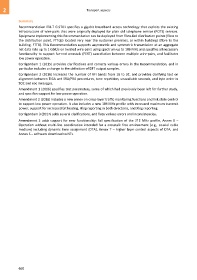Page 670 - 5G Basics - Core Network Aspects
P. 670
2 Transport aspects
Summary
Recommendation ITU-T G.9701 specifies a gigabit broadband access technology that exploits the existing
infrastructure of wire-pairs that were originally deployed for plain old telephone service (POTS) services.
Equipment implementing this Recommendation can be deployed from fibre-fed distribution points (fibre to
the distribution point, FTTdp) located very near the customer premises, or within buildings (fibre to the
building, FTTB). This Recommendation supports asymmetric and symmetric transmission at an aggregate
net data rate up to 1 Gbit/s on twisted wire-pairs using spectrum up to 106 MHz and specifies all necessary
functionality to support far-end crosstalk (FEXT) cancellation between multiple wire-pairs, and facilitates
low power operation.
Corrigendum 1 (2015) provides clarifications and corrects various errors in the Recommendation, and in
particular includes a change to the definition of DFT output samples.
Corrigendum 2 (2016) increases the number of RFI bands from 16 to 32, and provides clarifying text on
alignment between TIGA and SRA/FRA procedures, tone repetition, unavailable seconds, and byte order in
SOC and eoc messages.
Amendment 1 (2016) specifies test parameters, some of which had previously been left for further study,
and specifies support for low power operation.
Amendment 2 (2016) includes a new annex on cross-layer traffic monitoring functions and link state control
to support low power operation. It also includes a new 106 MHz profile with increased maximum transmit
power, support for increased bit loading, Hlog reporting in both directions, and Xlog reporting.
Corrigendum 3 (2017) adds several clarifications, and fixes various errors and inconsistencies.
Amendment 3 adds support for new functionality: full specification of the 212 MHz profile, Annex X –
Operation without multi-line coordination intended for a crosstalk free environment (e.g., coaxial cable
medium) including dynamic time assignment (DTA), Annex T – higher layer control aspects of DTA, and
Annex S – software download to NTs.
660

